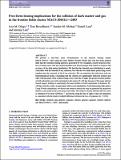Por favor, use este identificador para citar o enlazar a este item:
http://hdl.handle.net/10261/139975COMPARTIR / EXPORTAR:
 SHARE SHARE
 CORE
BASE CORE
BASE
|
|
| Visualizar otros formatos: MARC | Dublin Core | RDF | ORE | MODS | METS | DIDL | DATACITE | |

| Título: | Free-form lensing implications for the collision of dark matter and gas in the frontier fields cluster MACS J0416.1-2403 |
Autor: | Diego, José María CSIC ORCID ; Broadhurst, Tom; Molnar, Sandor M.; Lam, Daniel; Lim, Jeremy | Palabras clave: | Methods: data analysis Galaxies: clusters: individual: MACS J0416.1−2403 Dark matter Galaxies: clusters: general |
Fecha de publicación: | 2015 | Editor: | Oxford University Press | Citación: | Monthly Notices of the Royal Astronomical Society 447(4): 3130-3149 (2015) | Resumen: | We present a free-form mass reconstruction of the massive lensing cluster MACS J0416.1-2403 using the latest Hubble Frontier Fields data. Our free-form method finds that the extended lensing pattern is generated by two elongated, closely projected clusters of similar mass. Our lens model identifies new lensed images with which we improve the accuracy of the dark matter distribution. We find that the bimodal mass distribution is nearly coincident with the bimodal X-ray emission, but with the two dark matter peaks lying closer together than the centroids of the X-ray emission. We can reproduce this behaviour with our hydrodynamical model, concluding that the clusters are significantly deflected around each other with the plane of the collision lying close to the line of sight. The projected mass profiles of both subclusters are well constrained in the region 30-165 kpc because of the many interior lensed images, leading to surprisingly flat mass profiles of both components at distances 30-100 kpc from the centre, in agreement with recent simulations of self-interacting dark matter. Using N-body simulations, we discuss the extent to which this may be generated by projection effects in our model as the cores graze each other. The relative velocity between the two cores is estimated to be about 1200 km s-1 and mostly along the line of sight so that our simulation is consistent with the relative redshift difference between the two cD galaxies (δz ≈ 0.04). | Versión del editor: | https://doi.org/10.1093/mnras/stu2660 | URI: | http://hdl.handle.net/10261/139975 | DOI: | 10.1093/mnras/stu2660 | Identificadores: | doi: 10.1093/mnras/stu2660 issn: 0035-8711 e-issn: 1365-2966 |
| Aparece en las colecciones: | (IFCA) Artículos |
Ficheros en este ítem:
| Fichero | Descripción | Tamaño | Formato | |
|---|---|---|---|---|
| MACS J0416.pdf | 4,56 MB | Adobe PDF |  Visualizar/Abrir |
CORE Recommender
SCOPUSTM
Citations
50
checked on 21-abr-2024
WEB OF SCIENCETM
Citations
48
checked on 28-feb-2024
Page view(s)
262
checked on 24-abr-2024
Download(s)
270
checked on 24-abr-2024
Google ScholarTM
Check
Altmetric
Altmetric
NOTA: Los ítems de Digital.CSIC están protegidos por copyright, con todos los derechos reservados, a menos que se indique lo contrario.
